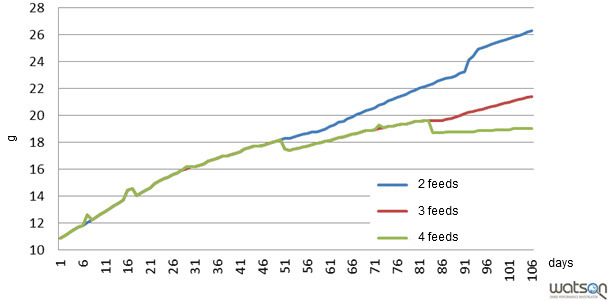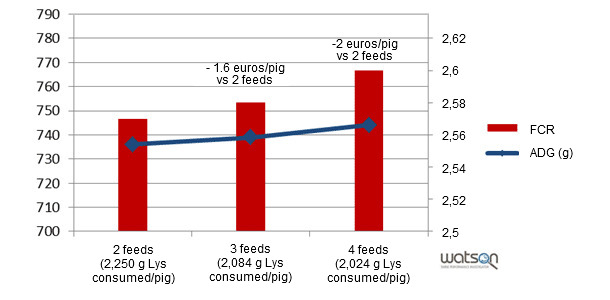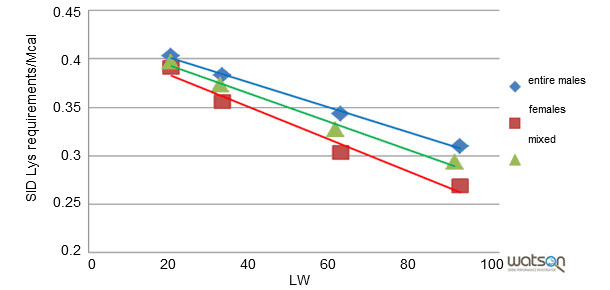With the aim of making his business as most profitable as possible, the pig producer needs to be able to evaluate, a priori, the technical-economic implications of possible changes in the management of their farm. The pig growth models are really useful for this, because they allow us to bear in mind, the multiple factors that affect the decision making, offering quite accurate estimates of the results when facing different scenarios.
Which is the impact of adding an extra feed to our feeding programme?

Being able to work with more feeds allows us to carry out a better adaptation between the animal's requirements and the supply of nutrients through the diet, improving the cost of the feeding thanks to a better management of the resources, and also with a lower environmental impact thanks to the lowering of the nitrogen excretions.
As an example, we shall start with the case of a farmer that wishes to change their feeding programme with 2 feeds (start of the fattening stage + single feed for the growth stage) for a programme with 3 or even 4 feeds, but they wish to know its implications in terms of zootechnical results, because they fear that the pigs 'stop growing' with the feeding change.
Working with more feed types would allow to adjust the intake of nutrients by the pigs and to avoid non productive inputs. For instance, if we represent the standardised ileal lysine input with the different feeding programmes, we see a clear reduction in the total intake of this amino acid as the number of feeds used increases.

Graph 1. Standardised ileal lysine intake along the growing-fattening stages with different feeding programmes (2 feeds, 3 feeds, 4 feeds)
In order to simulate the response of the animals when faced with the different feeding proposals, and bearing in mind the traits that define the farm, we use the growth models. Let us see this case:

Graph 2. Modelization of the zootechnical results depending on different feeding programmes (2 feeds, 3 feeds, 4 feeds)
According to the model, going from two stages to four would entail a drop in costs of almost €2/pig, with a worsening of 30 g in the feed conversion ratio, but keeping the same weight gain. It must also be highlighted that the excreted nitrogen would drop by 10%.

Graph 3. Nitrogen excreted in the growing-finishing stages depending on the model and according to the implemented feeding programme.
Must we change the feeding programme in summer?

Outside of the thermoneutral zone, in a cold environment, the pig reacts by increasing its feed intake with the aim of increasing heat production. In a hot environment, the pig will try to alleviate the heat stress by consuming less feed, moving away from the heat source and/or reducing its physical activity to a bare minimum (Steinbach, 1987). The drop in the feed intake will have an effect on the feed conversion ratio and the weight gain, as well as on its composition.

Graph 4. Evolution of the zootechnical parameters depending on the model, bearing in mind the temperature as the only variable.
Can we minimise these negative effects by adapting our feeding programme? Must we use more concentrated diets?
The answer to these questions will depend on multiple factors (genetics, temperature, relative humidity, material with which the floor is made, ventilation, insulation, availability of feeders, health state, etc.). The models allow us to consider all these factors simultaneously and to adapt the feeding programme to the circumstances.
So, comparing the results of the simulation with the original diets and with more concentrated diets (diets*), we see that we can partially overcome part of the negative effects of the high temperatures on the performance of the pigs.

Graph 5. Comparison of the results of simulations in hot periods using the original diets (IC, CMD, GMD) or more concentrated diets (IC*, CMD*, GMD*)
When analysing the global cost of the feed in the growing-fattening stages, the model shows that the higher cost of these more concentrated diets is economically compensated by the production performances.
Is the differentiated feeding depending on the gender during the fattening period worth it?
Some genetic lines show, at more or less 40-50 kg LW, differences in terms of protein deposition between entire males and females. In other lines, the divergence in terms of the protein deposition ability between entire males and females is delayed until 60-70 kg LW.

Graph 6. Protein deposition (g/day) of entire males and females of the genetic line A.

Graph 7. Protein deposition (g/day) of castrated males and females of the genetic line B.
By working with a growth model we can establish which is the best feeding model for each gender if we have the chance to fatten them separately, and we can simulate the expected technical and economic results for the farm. So, we will have data to evaluate if it is worth or not to divide the animals depending on their gender, and if it is worth, in case that this needed, to carry out some investments in our farm.

Graph 8. Standardised ileal lysine requirements per Mcal for the genetic line A

Graph 9. Standardised ileal lysine requirements per Mcal for the genetic line B
With the optimal SID lys/Energy relationships generated for each of the two genetic lines borne in mind, we can now quantify the differences and talk, in our example, of approximately 10% higher requirements of amino acids in entire males vs females in the genetic line A, and of more or less 10% higher requirements in females vs castrated males in the genetic line B.
Technical-economic results simulated with the model of the genetic strains A and B:
| Genetic line A | diff. €/pig | |||
| Optimal diet according to the model | FCR | ADG | ADI | vs mixed |
| Entire males | 2.50 | 731 | 1.83 | - 0.58 |
| Females | 2.66 | 732 | 1.95 | - |
| Mixed growth-fattening | 2.57 | 733 | 1.88 | - |
| Genetic line B | ||||
| Females | 2.89 | 736 | 2.13 | - |
| Castrated males | 2.95 | 778 | 2.29 | - 1.11 |
| Mixed growth-fattening | 2.93 | 751 | 2.20 | - |
In this example, the differentiated feeding depending on the gender would entail a saving of - €0.58/male for the genetic line A, and of - €1.11/castrated male for the genetic line B.
Here we have seen some examples about how the growth models can be a useful tool for making decisions, allowing us to consider simultaneously multiple variables and showing us trends when faced with different alternatives.


